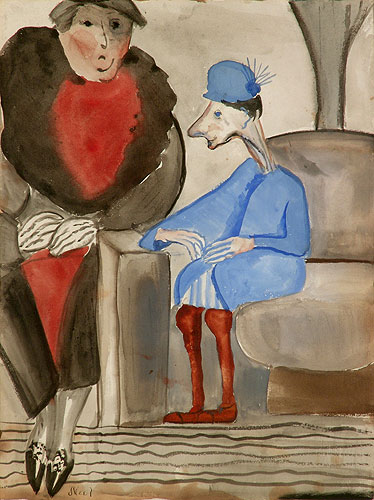 During the early years of the Great Depression, Alice Neel was one of the 3,749 artists who participated in the predecessor to the Federal Arts Project of the Works Progress Administration (WPA), the Public Works of Art Project, which operated during 1933-34.
During the early years of the Great Depression, Alice Neel was one of the 3,749 artists who participated in the predecessor to the Federal Arts Project of the Works Progress Administration (WPA), the Public Works of Art Project, which operated during 1933-34.
During that period, Neel was among the artists who were given a free meal every day in Greenwich Village. In the book “Alice Neel” by Patricia Hills, (Harry N. Abrams, Inc., New York, 1983 and reprinted 1995), she recalls:
“Contrasts,” 12 x 9 inches, 1927, Watercolor on Paper
“Then, at the end of 1933, I got on the PWAP. I received a letter to come down to the Whitney Museum, and there I was interviewed by a very nice young man who said, ‘How would you like to receive $30 a week for painting pictures?’ Oh, I said, I’d love it. And I came home and I felt so happy that I painted Snow on Cornelia Street. When I had $30 a week I didn’t need a free meal.”
Neel’s paintings were included in two 1977 exhibitions of WPA artists of the 1930s. One was a travelling exhibition organized by the Gallery Association of New York; another was held at Parsons School of Design.
Patricia Hills’ biography includes a photograph of Neel with her grandchildren, Olivia and Elizabeth, prominently printed on page 201, taken by Bill DuPriest during the Feb. 11, 1978 opening reception of Virginia Miller Galleries’ exhibition, “Alice Neel: Retrospective Works on Paper 1926-1977.”
Other photos of Neel during the opening reception at Virginia Miller Galleries in Coconut Grove, Florida, show her laughing uproariously during the viewing of the award-winning public television film, “Alice Neel: Collector of Souls.”
The historic exhibition, Neel’s first show in a private gallery in the South, featured several of the works illustrated in the book, including the 1931 pencil and watercolor “Kenneth Doolittle” shown on page 43; the 1932 watercolor and collage titled “Christopher Lazar” on page 47; the 1958 oil on paper of John Rothschild titled “Man in Striped Shirt” on page 74; and both of the 1949 ink on paper drawings of “Judge Medina” and “Angela Calomaris” on page 87.
One of the works sold from the exhibition, a 12-by-9-inch 1927 watercolor titled “Contrasts,” presently is being offered on the gallery web site under the “Masters” category of “Artists.”
“Alice was acutely aware of the enormous gap between the wealthy and the poor and working-class people back in the 1920s,” observes gallery owner Virginia Miller. “Several of the works that I curated into her exhibition showed underprivileged people in hospitals and elsewhere. This charming watercolor is an important example of Alice Neel’s deep awareness of the gap between the social classes, and how the wealthy dominated society in those days.”
Another watercolor in the show, the 1927 work titled “The Grandchild,” is printed in the Patricia Hills biography on page 19. It also illustrated a review of the Neel exhibition by Dr. Marilyn Schmitt, a University of Miami art professor, in “ARTSmagazine.”
In her review, Dr. Schmitt noted that the artist’s social concerns were lifelong. “Her early socialist convictions, scarcely mellowed today one senses, provide the thread of continuity for several drawings in strikingly different styles. Where the political message is strongest, as in The Bowery (early 1950s) and the caricature of the hated Communist-chaser Judge Harold R. Medina and his witness Angela Calomeris (1949), the technique is at its most strident, unpleasant, and laborious in its avoidance of grace.
“In others, the social message is subsumed in human and aesthetic concerns. In The Men From Bleeker Street (1933) and the death portrait of Mother Bloor in her casket (1951), drawings united by strongly leftist preoccupations despite almost 20 years’ separation, the sense of humanity dominates, and the delicate line is correspondingly
sensitive and appealing.”
Only one oil on canvas was in the exhibition, the five-foot portrait that Alice did of Virginia Miller just a few months before her Coconut Grove show.
“Alice asked me to sit for her when we met at a two-day seminar at the New School in late 1977,” recalls Miller. “I was on a panel on functioning in the art world with Louise Nevelson, the art dealer Jacques Truman, art insurer Huntington Block, and several others. Alice was on another panel that included art dealer Ivan Karp and the prominent curator and critic Henry Geldzahler.
“When Alice complained that Geldzahler had not included her work in a recent exhibition, he explained it was because she was ‘not modern.’ This infuriated Alice, and when she resumed work on my portrait she splashed several broad strokes of green paint across the background and told me, ‘I’ll show him who’s modern!’”
Miller, who had braved thigh-deep snowdrifts in that year’s famous blizzard to struggle from midtown to Alice’s apartment in Spanish Harlem, says the expressionist onslaught had her worried, but Alice soon calmed down and the portrait is an unflattering but excellent likeness that exaggerates Miller’s six-foot angularity. It may be seen on the gallery web site under “Gallery.”
“As far as I know, mine is the only painting Alice Neel ever did with that sort of abstract expressionist background,” Miller says.
Dr. Schmitt’s review also covered a concurrent exhibition of Alice Neel’s canvases at the Fort Lauderdale Museum of Art. She observes that “the portraits on canvas might well be called extensions of Neel’s drawings, for their initiating outlines survive in the finished products and the changes of mind are left, as in a sketch.” She adds that Neel “is a major artist of the 20th century. We can judge for ourselves an art world that celebrated far weaker stuff while ignoring her. Against that backdrop, Alice Neel is a giant.”
